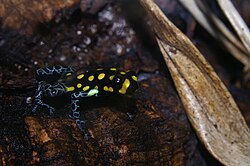| Image | Scientific name | Distribution |
|---|
 | Ranitomeya aetherea
Koch, Mônico, Dayrell, Ferreira, Dantas, Moravec, and Lima, 2025 | Juruá River basin, western Brazil |
 | Ranitomeya amazonica
(Schulte, 1999) | northeastern Amazonian Peru (Loreto Region, including the type locality) and extreme southeastern Colombia (Amazonas Department), and expected in the adjacent Brazil, Venezuela; extreme southern Guyana; eastern French Guiana; the mouth of the Amazon in Brazil |
 | Ranitomeya aquamarina
Mônico, Koch, Dayrell, Moravec and Lima, 2025 | Juruá River basin, western Brazil |
 | Ranitomeya benedicta
Brown, Twomey, Pepper, and Sanchez-Rodriguez, 2008 | |
| Ranitomeya cyanovittata
Pérez-Peña, Chávez, Twomey, and Brown, 2010 | Pampas del Sacramento in southern Loreto and eastern San Martín Region, northeastern Peru |
| Ranitomeya defleri
Twomey and Brown, 2009 | southeastern Colombia |
 | Ranitomeya fantastica
(Boulenger, 1884) | eastern Sierra del Divisor, Loreto, Peru |
| Ranitomeya flavovittata
(Schulte, 1999) | northern San Martín and Loreto Regions, Peru |
 | Ranitomeya imitator
(Schulte, 1986) | Loreto Region, Peru |
 | Ranitomeya reticulata
(Boulenger, 1884) | eastern Peru. |
 | Ranitomeya sirensis
(Aichinger, 1991) | Amazon rainforest in Peru and Ecuador. |
 | Ranitomeya summersi
Brown, Twomey, Pepper, and Sanchez-Rodriguez, 2008 | central Huallaga River drainage and adjacent Cordillera Azul National Park in central Peru |
| Ranitomeya toraro
Brown, Caldwell, Twomey, Melo-Sampaio, and Souza, 2011 | western Brazil in the states of Acre and Amazonas, and in the north of Rondônia state |
 | Ranitomeya uakarii
(Brown, Schulte, and Summers, 2006) | southern Peru (Madre de Dios), central Peru (Pachitea drainage), western Brazil (near Porto Walter), along the upper Amazon (in Peru and Colombia), and as far west as central Guyana. |
 | Ranitomeya vanzolinii
(Myers, 1982) | Amazonian rainforests of Brazil and Peru |
 | Ranitomeya variabilis
(Zimmermann and Zimmermann, 1988) | Huallaga River drainage of San Martín Region, Peru |
 | Ranitomeya ventrimaculata
(Shreve, 1935) | Brazil, southeastern Colombia, Ecuador, French Guiana, and Peru. |
| Ranitomeya yavaricola
Pérez-Peña, Chávez, Twomey, and Brown, 2010 | Rio Yavari-Mirin, Loreto, Peru |
|












